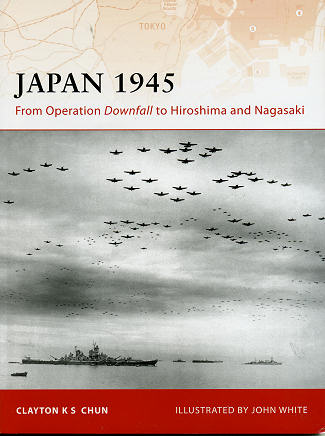 It is
somewhat surprising to me that we don't see more written on the end of the war
in the Pacific. Or it could be that I just don't get to read much on it. Either
way, it is nice to have a look at the preparations for the invasion of Japan,
the intelligence on what to expect, the thoughts of those who were going to plan
the event, the plans and resources of the Japanese, and what eventually happened
to end the war. That is one very long sentence.
It is
somewhat surprising to me that we don't see more written on the end of the war
in the Pacific. Or it could be that I just don't get to read much on it. Either
way, it is nice to have a look at the preparations for the invasion of Japan,
the intelligence on what to expect, the thoughts of those who were going to plan
the event, the plans and resources of the Japanese, and what eventually happened
to end the war. That is one very long sentence.
The invasion of Japan was seen on the American side as
something they'd rather not do, but was seen to be inevitable. The ferocity of
the Japanese defense of Okinawa was a portent of the huge number of casualties
to be expected during a landing. While it was hoped that the Soviets would take
away some of the strain in Manchuria, the truth is that the Japanese had pulled
out most of its defensive forces from that area to bolster the home islands so
the Soviets had pretty much an easy go of things.
I found it interesting that the Japanese were planning to
build up and defend the very areas that he Allies had chosen to land on Kyushu
and later on Honshu itself. It seems the most likely landing sites were quite
apparent. As you can imagine, much of the book is involved on the decision to
use the atomic bombs or not. McArthur in particular wanted to use them to try to
end the war as quickly as possible so as to keep the Soviets out of Japan. He
foresaw that including them in the invasion or occupation forces would be
nothing but trouble, and events elsewhere have since borne out this
consideration.
As is the norm for a book in the Campaign series, this one
starts with a preamble of events leading up to the events covered, a look at the
commanders of both sides and the men under their command. Then there is an
inspection of the plans of both sides. The 'meat' of the volume is next with the
various stages of preparation and planning. Finally, a look at the dropping of
the two bombs on Hiroshima and Nagasaki, what was learned, and how it
affected future events. There is also a look at the battlefield today, which
pretty much is contained to the two Japanese cities. All of
this is superbly illustrated using period photograph and the superb illustrations and
artwork of John White to add some color to things.
I have to say that this is really an excellent book on
this pivotal series of events. One that shaped much of what happened to the
world over the next 40 years or so. A book I know you will enjoy reading.
November 2008
For more on the complete line of Osprey books,
visit www.ospreypublishing.com. In the US, it is
Osprey Direct at 44-02 23rd St, Suite 219, Long Island City, NY 11101., where you can
get a catalogue of available books.
If you would like your product reviewed fairly and quickly, please contact
me or see other details in the Note to
Contributors.
 It is
somewhat surprising to me that we don't see more written on the end of the war
in the Pacific. Or it could be that I just don't get to read much on it. Either
way, it is nice to have a look at the preparations for the invasion of Japan,
the intelligence on what to expect, the thoughts of those who were going to plan
the event, the plans and resources of the Japanese, and what eventually happened
to end the war. That is one very long sentence.
It is
somewhat surprising to me that we don't see more written on the end of the war
in the Pacific. Or it could be that I just don't get to read much on it. Either
way, it is nice to have a look at the preparations for the invasion of Japan,
the intelligence on what to expect, the thoughts of those who were going to plan
the event, the plans and resources of the Japanese, and what eventually happened
to end the war. That is one very long sentence.